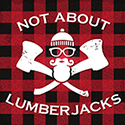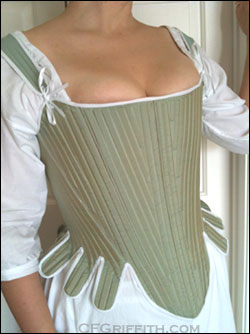 It unfortunately took me a while to finish my stays due to various reasons (travel and conferences, researching and decision-making, and mental health breaks), but I’m very pleased with how they turned out! As usual, I’m hoping they last for a while — part of the learning process for me is seeing how my sewing holds up to wear and tear over time — but I think they’ll work for a little while at least.
It unfortunately took me a while to finish my stays due to various reasons (travel and conferences, researching and decision-making, and mental health breaks), but I’m very pleased with how they turned out! As usual, I’m hoping they last for a while — part of the learning process for me is seeing how my sewing holds up to wear and tear over time — but I think they’ll work for a little while at least.
Made my own “pattern”
I decided I didn’t want to buy a pattern since I would still have to deal with size and fitting. I also have the book Corsets and Crinolines by Norah Waugh, and I have never had a chance to make clothing from the historical pattern books I have. There was a design for stays (page 39, Fully-boned stays/1730-1740) that I really liked the look of. Of course, I couldn’t leave it alone and decided to make the front part plain, instead of the stomacher that’s part of the original design.
I really didn’t know what I was doing, so I took some “graph” fabric (Tru-Grid graph material) and estimated the size of length and transferred (rounding up here and there — I figured it would be better to have too much to work with, than too little). I should have been better at figuring out the sizes, but when I ended up working on it, I was still not sure I was actually starting the process at that time. It was one of those “let me see… if I do this…” moments that kept going. Plus, it was late at night and I just couldn’t get it off my mind. It just sort of happened in an unplanned way.
Mockups and changes
The original mockup was off here and there, but it gave me a feel for how to proceed and what I needed to do. I made the changes, and version two turned out much closer. There was a little more tweaking and changing, but most of the panels at that point were what I ended up with.
I decided that I would make the stays as tight as possible to allow for weight-loss. With all the time I was putting into them, I didn’t want to have to make another one any time soon. I usually make a fabric mockup just to test things, and I need to stop doing that (more on that later). I didn’t have any boning in my mockup, so while I had a feeling most of the fit would be fine, there was one area I couldn’t really test that worried me a little.
Worries
It was amusing, actually, that I wasn’t too concerned about the fit of the stays. Even if they were tight, they would be strong enough to pull where needed. No, my biggest worry was about the tabs. The design I picked has long tabs, and they overlap on the sides over the hips. Mine seemed to be overlapping too much, and I couldn’t imagine how they were supposed to spread out and not be in each others’ way. I’m honestly not even sure if there is a way to test these types of tabs without making the stays out of the actual materials. I had a few people reassuring me, and I decided to just dive in and see how they would turn out.
My next worry was the waistline. The design I was going for seemed to be very long-waisted, and I had actually made another pattern to make my stays longer. I decided not to use it because I didn’t like the way it looked on me, and I just didn’t feel as confident about that version. My current stays may not be long enough in the waist, but the fit is nice and it works for me at the moment.
The materials
I decided to use long cable ties (varying lengths) for the boning, and make them fully-boned. My husband helped me pick out some outer fabric. He was a huge help since I was torn between two or three fabrics. We chose a silk taffeta made out of golden-orange thread, and a turquoise-blue thread. The resulting color differs depending on how it’s angled, and the lighting. Sometimes it shimmers a golden color with a light sage green, and other times I’ve seen it pick up the blue. It was a subtle color change, which we both loved. The inner fabric is a bottom weight canvas we chose because it was thin enough, but had almost no give when we were tugging on it in the store. I used two layers of the canvas, putting the boning in between those, and flat lining the silk to the top canvas layer. I decided to skip the lining, because I wanted to cut a step out and didn’t think it would be an issue. I also wanted access to the seams on the inside, just in case there were any problems.
Blood, sweat, and tears
Unfortunately, what turned out to be a good base fabric choice for strength, was a terrible choice for hand-sewing. Pain! That fabric was so hard to do certain types of stitches on. I’m still a little lazy with thread, so I didn’t use any special types of threads, nor did I prep them. I had to use fresh thread sooner than I normally would, because the fabric was shredding the thread with certain stitches. It also caused lots of stabbing and jabbing, even with a thimble. The inside of my stays are a little sloppy, but that’s okay — no one is going to see it.
Finishing touches
The eyelets are all hand-sewn. I wish I had been more confident with those, because I ended up doing an extra step I didn’t need. I’m used to finishing eyelets with a buttonhole stitch. I had created a practice piece, using the layers of fabrics from scraps, but I had such a terrible time at first, getting them to look nice that I was paranoid about doing them without the buttonhole stitch. The first eyelet I did on the stays, would have been just fine without, but since I added the stitch, I had to make them all that way. In all honesty, they would have looked better without! Oh well. Next time I know better, and to trust my skills enough to just go for it. I’m also amazed the eyelets are so strong!
The bias tape is store-bought, because I wanted to save myself some time and trouble, not to mention some money. I desperately need to buy a rotary cutter, and a cutting mat. This is only the second time I’ve edged something like this (my Victorian corset was the first), so I figured another practice run with store-bought would be fine. Honestly, it’s such a thin line, I didn’t think it would make much of a difference. Thankfully, it went on a lot smoother than I thought it would, although stitching the binding around the inner corners of the tabs was definitely annoying.
What I learned for next time
There are some things I will probably deal with again next time (I still have plenty of the canvas left, so I’m sure there will be more stabbed fingers and shredded thread again in the future), but hopefully I’ve learned my lesson on some of the others:
- Use the cardboard fitting technique. I didn’t even know about this until I was already past the fitting part.
- Be a little more accurate with transferring lines and creating the pattern.
- Finish the edges to diminish fraying and so I don’t have to mess with it later.
- Find another cutting method for the zip ties. The tool I used had trouble cutting acute, long angles. Filing dulled down the points, so I’m not too worried about that, but it could be an issue in some spots.
- Maybe do more research next time to see if changing thread or preparing thread would be worthwhile.
- Definitely don’t be afraid — move on and have a little confidence!
- Feel confident enough with the eyelets to skip the buttonhole stitch finish.
It took a while, but I’m happy
It definitely took me far too long to finish the stays. I was unfamiliar with the fit and feel of them (I’ve only worn hourglass-shaping corsets), but knew how vital it was to get the proper period shape and support. Fortunately, it worked out and I’m very pleased with my first stays. Hopefully the next stays I make will go a lot smoother, but I think having made a few corset-like garments and carefully researching the subject as well as looking at a lot of art and photos helped me figure out what I needed to do.
Don’t be nervous to give something like this a try. You might decide to buy a pattern to save a little trouble with sizing and fitting, but there is a lot of helpful information on the Internet that explains the construction. There are also designs for half-boned stays, which are still very sturdy.
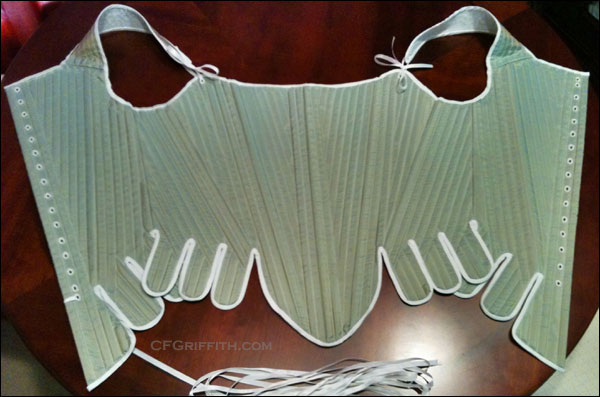
The tabs over the hips overlap when they're like this, but spread out when I'm wearing them.
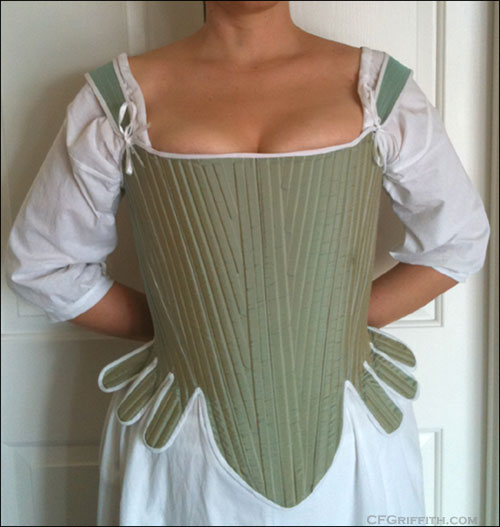
The small dark spot on the right side of the photo (my left) is a sweat stain. I hold the stays there with my arms while my husband helps lace the stays. We're getting the hang of it, but I admit I like Victorian corsets better with the front busk.
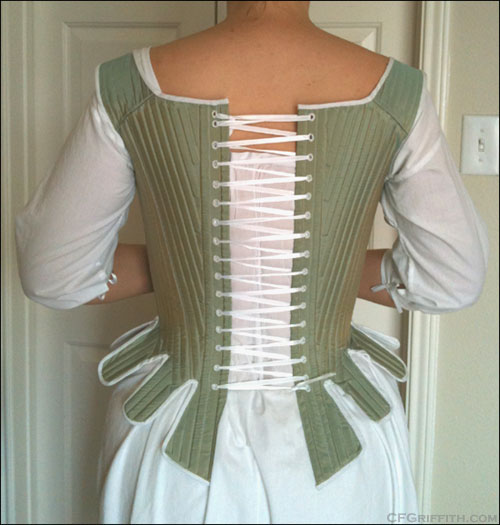
My husband is getting the hang of lacing the stays and helping me keep the shift from bunching up. The bit of white on the bottom right corner is the loose end of the ribbon where it's tied (knotted right now) to the stays. I need to tuck it or trim it.
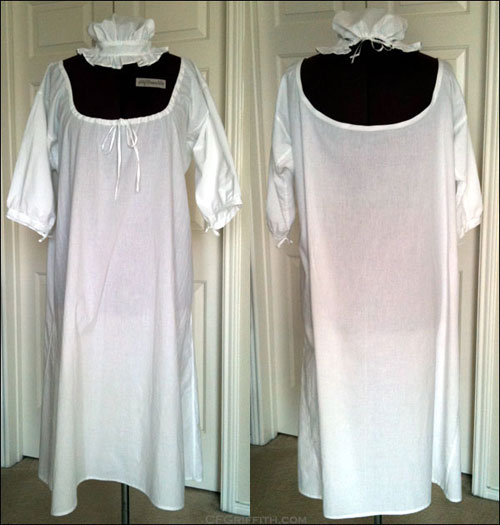
Finally finished my first 18th century shift (the neckline was last). I made the neckline as low as possible -- better to have it too loose, than showing in the neckline of the garments. My first cap is on top of the dressform.
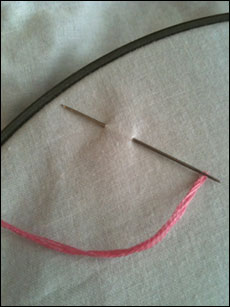


 It unfortunately took me a while to finish my stays due to various reasons (travel and conferences, researching and decision-making, and mental health breaks), but I’m very pleased with how they turned out! As usual, I’m hoping they last for a while — part of the learning process for me is seeing how my sewing holds up to wear and tear over time — but I think they’ll work for a little while at least.
It unfortunately took me a while to finish my stays due to various reasons (travel and conferences, researching and decision-making, and mental health breaks), but I’m very pleased with how they turned out! As usual, I’m hoping they last for a while — part of the learning process for me is seeing how my sewing holds up to wear and tear over time — but I think they’ll work for a little while at least.



 I talk a lot about my husband,
I talk a lot about my husband, 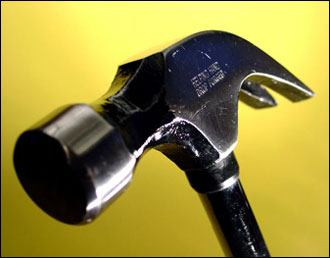 Christopher and I have been sick for just over a week, so I took the time to do some work on my site instead of sewing. I’ve made a lot of behind-the-scenes changes, and I’m now starting to add a few of the things I’ve been needing to add (the galleries will be a little while, still).
Christopher and I have been sick for just over a week, so I took the time to do some work on my site instead of sewing. I’ve made a lot of behind-the-scenes changes, and I’m now starting to add a few of the things I’ve been needing to add (the galleries will be a little while, still). It occurred to me recently, when I was looking at supplies I needed to buy for sewing, just how quickly the money adds up with a hobby like this. The problem with sewing is that many people don’t realize what goes into it if they don’t sew.
It occurred to me recently, when I was looking at supplies I needed to buy for sewing, just how quickly the money adds up with a hobby like this. The problem with sewing is that many people don’t realize what goes into it if they don’t sew.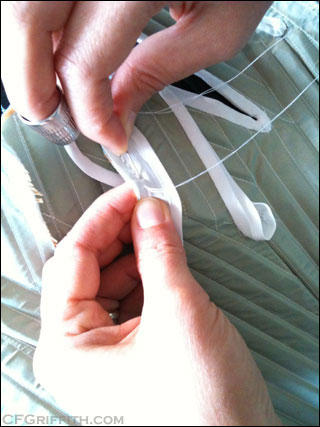 I’m currently sewing the binding on the tabs of my stays. I’ve read people complaining about what a chore sewing the binding on the tabs is. They’re not kidding! I’d actually read a tip or two that mentioned you might want to start on the tabbed edge first, so the top edge would be a nice break after dealing with the tabs. I considered it at first, but decided that I wanted to warm up by binding the top side first. I’m glad I did. I got a feel for how everything is working together, but I’m still slowing down in sections!
I’m currently sewing the binding on the tabs of my stays. I’ve read people complaining about what a chore sewing the binding on the tabs is. They’re not kidding! I’d actually read a tip or two that mentioned you might want to start on the tabbed edge first, so the top edge would be a nice break after dealing with the tabs. I considered it at first, but decided that I wanted to warm up by binding the top side first. I’m glad I did. I got a feel for how everything is working together, but I’m still slowing down in sections!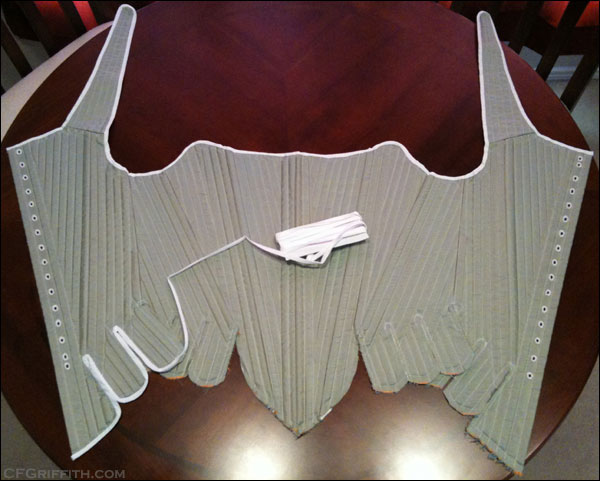
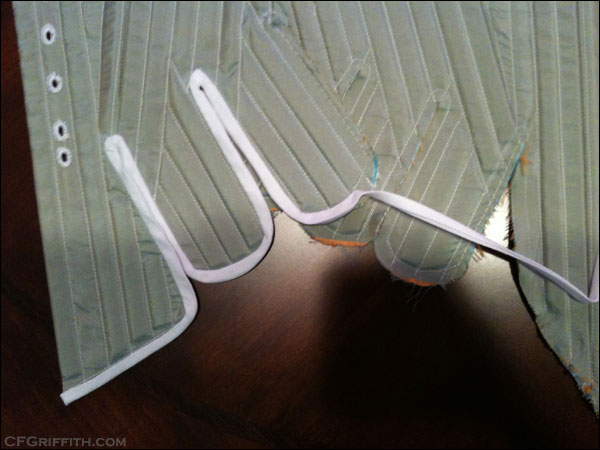
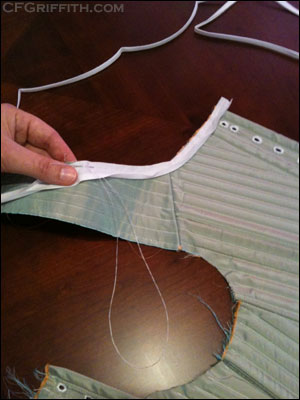
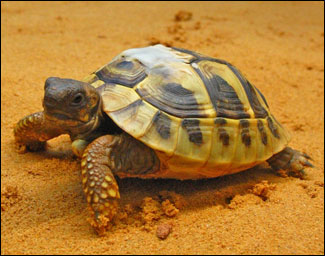 Sorry my sewing entries have slowed down again — there hasn’t been much going on project-wise. My stays are close to being finished, but I admit I’ve not been focused enough to work on them. I’d been very annoyed with myself for not pushing myself harder on some projects, but I realized I need to cut myself some slack. I’ve had other things on my mind.
Sorry my sewing entries have slowed down again — there hasn’t been much going on project-wise. My stays are close to being finished, but I admit I’ve not been focused enough to work on them. I’d been very annoyed with myself for not pushing myself harder on some projects, but I realized I need to cut myself some slack. I’ve had other things on my mind. I just wanted to wish my husband a congratulations on his blog,
I just wanted to wish my husband a congratulations on his blog, 